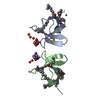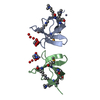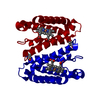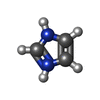[English] 日本語
 Yorodumi
Yorodumi- PDB-4e6r: Crystal structure of a Cytoplasmic protein NCK2 (NCK2) from Homo ... -
+ Open data
Open data
- Basic information
Basic information
| Entry | Database: PDB / ID: 4e6r | ||||||
|---|---|---|---|---|---|---|---|
| Title | Crystal structure of a Cytoplasmic protein NCK2 (NCK2) from Homo sapiens at 2.20 A resolution | ||||||
 Components Components | Cytoplasmic protein NCK2 | ||||||
 Keywords Keywords | SUGAR BINDING PROTEIN / SH3 domain / protein binding / Structural Genomics / Joint Center for Structural Genomics / JCSG / Protein Structure Initiative / PSI-BIOLOGY / Partnership for T-Cell Biology / TCELL | ||||||
| Function / homology |  Function and homology information Function and homology informationRegulation of cortical dendrite branching / regulation of translation initiation in response to endoplasmic reticulum stress / positive regulation of translation in response to endoplasmic reticulum stress / positive regulation of endoplasmic reticulum stress-induced intrinsic apoptotic signaling pathway / immunological synapse formation / dendritic spine development / cytoskeletal anchor activity / signal complex assembly / Activation of RAC1 / Nephrin family interactions ...Regulation of cortical dendrite branching / regulation of translation initiation in response to endoplasmic reticulum stress / positive regulation of translation in response to endoplasmic reticulum stress / positive regulation of endoplasmic reticulum stress-induced intrinsic apoptotic signaling pathway / immunological synapse formation / dendritic spine development / cytoskeletal anchor activity / signal complex assembly / Activation of RAC1 / Nephrin family interactions / vesicle membrane / Ephrin signaling / lamellipodium assembly / RHOV GTPase cycle / negative regulation of PERK-mediated unfolded protein response / positive regulation of actin filament polymerization / RHOU GTPase cycle / ephrin receptor signaling pathway / positive regulation of T cell proliferation / phosphotyrosine residue binding / signaling adaptor activity / Downstream signal transduction / actin filament organization / T cell activation / receptor tyrosine kinase binding / VEGFA-VEGFR2 Pathway / epidermal growth factor receptor signaling pathway / cell migration / signaling receptor complex adaptor activity / scaffold protein binding / postsynaptic density / negative regulation of cell population proliferation / protein-containing complex binding / negative regulation of transcription by RNA polymerase II / endoplasmic reticulum / signal transduction / positive regulation of transcription by RNA polymerase II / cytosol / cytoplasm Similarity search - Function | ||||||
| Biological species |  Homo sapiens (human) Homo sapiens (human) | ||||||
| Method |  X-RAY DIFFRACTION / X-RAY DIFFRACTION /  SYNCHROTRON / SYNCHROTRON /  MAD / Resolution: 2.2 Å MAD / Resolution: 2.2 Å | ||||||
 Authors Authors | Joint Center for Structural Genomics (JCSG) / Partnership for T-Cell Biology (TCELL) | ||||||
 Citation Citation |  Journal: To be published Journal: To be publishedTitle: Crystal structure of a Cytoplasmic protein NCK2 (NCK2) from Homo sapiens at 2.20 A resolution Authors: Joint Center for Structural Genomics (JCSG) / Partnership for T-Cell Biology (TCELL) | ||||||
| History |
|
- Structure visualization
Structure visualization
| Structure viewer | Molecule:  Molmil Molmil Jmol/JSmol Jmol/JSmol |
|---|
- Downloads & links
Downloads & links
- Download
Download
| PDBx/mmCIF format |  4e6r.cif.gz 4e6r.cif.gz | 64.3 KB | Display |  PDBx/mmCIF format PDBx/mmCIF format |
|---|---|---|---|---|
| PDB format |  pdb4e6r.ent.gz pdb4e6r.ent.gz | 50.8 KB | Display |  PDB format PDB format |
| PDBx/mmJSON format |  4e6r.json.gz 4e6r.json.gz | Tree view |  PDBx/mmJSON format PDBx/mmJSON format | |
| Others |  Other downloads Other downloads |
-Validation report
| Summary document |  4e6r_validation.pdf.gz 4e6r_validation.pdf.gz | 451.1 KB | Display |  wwPDB validaton report wwPDB validaton report |
|---|---|---|---|---|
| Full document |  4e6r_full_validation.pdf.gz 4e6r_full_validation.pdf.gz | 452.2 KB | Display | |
| Data in XML |  4e6r_validation.xml.gz 4e6r_validation.xml.gz | 7.8 KB | Display | |
| Data in CIF |  4e6r_validation.cif.gz 4e6r_validation.cif.gz | 9.7 KB | Display | |
| Arichive directory |  https://data.pdbj.org/pub/pdb/validation_reports/e6/4e6r https://data.pdbj.org/pub/pdb/validation_reports/e6/4e6r ftp://data.pdbj.org/pub/pdb/validation_reports/e6/4e6r ftp://data.pdbj.org/pub/pdb/validation_reports/e6/4e6r | HTTPS FTP |
-Related structure data
| Similar structure data | |
|---|---|
| Other databases |
- Links
Links
- Assembly
Assembly
| Deposited unit | 
| ||||||||||||||||||||||||||||||||||||||||||||||||
|---|---|---|---|---|---|---|---|---|---|---|---|---|---|---|---|---|---|---|---|---|---|---|---|---|---|---|---|---|---|---|---|---|---|---|---|---|---|---|---|---|---|---|---|---|---|---|---|---|---|
| 1 | 
| ||||||||||||||||||||||||||||||||||||||||||||||||
| Unit cell |
| ||||||||||||||||||||||||||||||||||||||||||||||||
| Noncrystallographic symmetry (NCS) | NCS domain:
NCS domain segments:
NCS ensembles :
| ||||||||||||||||||||||||||||||||||||||||||||||||
| Details | CRYSTAL PACKING ANALYSIS SUGGESTS THE ASSIGNMENT OF A TETRAMER AS THE SIGNIFICANT OLIGOMERIZATION STATE. |
- Components
Components
| #1: Protein | Mass: 6779.484 Da / Num. of mol.: 2 / Fragment: SH3 2 domain residues 114-170 Source method: isolated from a genetically manipulated source Source: (gene. exp.)  Homo sapiens (human) / Gene: BC007195, GRB4, NCK2 / Plasmid: SpeedET / Production host: Homo sapiens (human) / Gene: BC007195, GRB4, NCK2 / Plasmid: SpeedET / Production host:  #2: Chemical | ChemComp-ZN / #3: Chemical | #4: Chemical | Num. of mol.: 2 / Source method: obtained synthetically #5: Water | ChemComp-HOH / | Sequence details | 1. THIS CONSTRUCT WAS EXPRESSED WITH A PURIFICATION TAG MGSDKIHHHHHHENLYFQG. THE TAG WAS REMOVED ...1. THIS CONSTRUCT WAS EXPRESSED WITH A PURIFICATI | |
|---|
-Experimental details
-Experiment
| Experiment | Method:  X-RAY DIFFRACTION / Number of used crystals: 1 X-RAY DIFFRACTION / Number of used crystals: 1 |
|---|
- Sample preparation
Sample preparation
| Crystal | Density Matthews: 4.27 Å3/Da / Density % sol: 71.16 % |
|---|---|
| Crystal grow | Temperature: 277 K / Method: vapor diffusion, sitting drop / pH: 8 Details: 40.00% polyethylene glycol 300, 0.20M zinc acetate, 0.1M Imidazole pH 8.0, NANODROP, VAPOR DIFFUSION, SITTING DROP, temperature 277K |
-Data collection
| Diffraction | Mean temperature: 100 K | |||||||||||||||||||||||||||||||||||||||||||||||||||||||||||||||||||||||||||||||||||||||||||||||||||||||||||||||||||||||||||||||||||||||||||||||||||
|---|---|---|---|---|---|---|---|---|---|---|---|---|---|---|---|---|---|---|---|---|---|---|---|---|---|---|---|---|---|---|---|---|---|---|---|---|---|---|---|---|---|---|---|---|---|---|---|---|---|---|---|---|---|---|---|---|---|---|---|---|---|---|---|---|---|---|---|---|---|---|---|---|---|---|---|---|---|---|---|---|---|---|---|---|---|---|---|---|---|---|---|---|---|---|---|---|---|---|---|---|---|---|---|---|---|---|---|---|---|---|---|---|---|---|---|---|---|---|---|---|---|---|---|---|---|---|---|---|---|---|---|---|---|---|---|---|---|---|---|---|---|---|---|---|---|---|---|---|
| Diffraction source | Source:  SYNCHROTRON / Site: SYNCHROTRON / Site:  SSRL SSRL  / Beamline: BL9-2 / Wavelength: 0.91837,0.97949,0.97929 / Beamline: BL9-2 / Wavelength: 0.91837,0.97949,0.97929 | |||||||||||||||||||||||||||||||||||||||||||||||||||||||||||||||||||||||||||||||||||||||||||||||||||||||||||||||||||||||||||||||||||||||||||||||||||
| Detector | Type: MARMOSAIC 325 mm CCD / Detector: CCD / Date: Jan 12, 2012 / Details: double crystal monochromator | |||||||||||||||||||||||||||||||||||||||||||||||||||||||||||||||||||||||||||||||||||||||||||||||||||||||||||||||||||||||||||||||||||||||||||||||||||
| Radiation | Monochromator: double crystal / Protocol: MAD / Monochromatic (M) / Laue (L): M / Scattering type: x-ray | |||||||||||||||||||||||||||||||||||||||||||||||||||||||||||||||||||||||||||||||||||||||||||||||||||||||||||||||||||||||||||||||||||||||||||||||||||
| Radiation wavelength |
| |||||||||||||||||||||||||||||||||||||||||||||||||||||||||||||||||||||||||||||||||||||||||||||||||||||||||||||||||||||||||||||||||||||||||||||||||||
| Reflection | Resolution: 2.2→28.862 Å / Num. all: 12480 / Num. obs: 12480 / % possible obs: 100 % / Redundancy: 14 % / Biso Wilson estimate: 40.198 Å2 / Rsym value: 0.2 / Net I/σ(I): 11.4 | |||||||||||||||||||||||||||||||||||||||||||||||||||||||||||||||||||||||||||||||||||||||||||||||||||||||||||||||||||||||||||||||||||||||||||||||||||
| Reflection shell | Rmerge(I) obs: 0.021 / Diffraction-ID: 1
|
-Phasing
| Phasing | Method:  MAD MAD |
|---|
- Processing
Processing
| Software |
| |||||||||||||||||||||||||||||||||||||||||||||||||||||||||||||||||||||||||||
|---|---|---|---|---|---|---|---|---|---|---|---|---|---|---|---|---|---|---|---|---|---|---|---|---|---|---|---|---|---|---|---|---|---|---|---|---|---|---|---|---|---|---|---|---|---|---|---|---|---|---|---|---|---|---|---|---|---|---|---|---|---|---|---|---|---|---|---|---|---|---|---|---|---|---|---|---|
| Refinement | Method to determine structure:  MAD / Resolution: 2.2→28.862 Å / Cor.coef. Fo:Fc: 0.95 / Cor.coef. Fo:Fc free: 0.94 / Occupancy max: 1 / Occupancy min: 0.4 / SU B: 9.612 / SU ML: 0.125 / Cross valid method: THROUGHOUT / σ(F): 0 / ESU R: 0.165 / ESU R Free: 0.15 MAD / Resolution: 2.2→28.862 Å / Cor.coef. Fo:Fc: 0.95 / Cor.coef. Fo:Fc free: 0.94 / Occupancy max: 1 / Occupancy min: 0.4 / SU B: 9.612 / SU ML: 0.125 / Cross valid method: THROUGHOUT / σ(F): 0 / ESU R: 0.165 / ESU R Free: 0.15 Stereochemistry target values: MAXIMUM LIKELIHOOD WITH PHASES Details: 1. HYDROGENS HAVE BEEN ADDED IN THE RIDING POSITIONS. 2. ATOM RECORD CONTAINS SUM OF TLS AND RESIDUAL B FACTORS. 3. ANISOU RECORD CONTAINS SUM OF TLS AND RESIDUAL U FACTORS. 4. WATERS WERE ...Details: 1. HYDROGENS HAVE BEEN ADDED IN THE RIDING POSITIONS. 2. ATOM RECORD CONTAINS SUM OF TLS AND RESIDUAL B FACTORS. 3. ANISOU RECORD CONTAINS SUM OF TLS AND RESIDUAL U FACTORS. 4. WATERS WERE EXCLUDED FROM AUTOMATIC TLS ASSIGNMENT. 5. A MET-INHIBITION PROTOCOL WAS USED FOR SELENOMETHIONINE INCORPORATION DURING PROTEIN EXPRESSION. THE OCCUPANCY OF THE SE ATOMS IN THE MSE RESIDUES WAS REDUCED TO 0.75 FOR THE REDUCED SCATTERING POWER DUE TO PARTIAL S-MET INCORPORATION. 6. X-RAY FLUORESCENCE EXCITATION AND WAVELENGTH SCANS, ANOMALOUS DIFFERENCE FOURIERS AND ITS PRESENCE IN CRYSTALLIZATION SOLUTION SUPPORT THE MODELING OF ZINC (ZN) IONS. 7. LYSINE RESIDUES WERE METHYLATED PRIOR TO CRYSTALLIZATION AND ARE MODELED AS DIMETHYL-LYSINE (MLY). THE N-TERMINAL GLYCINE RESIDUES WERE ALSO METHYLATED IN THIS PROCEDURE AND ARE MODELED AS N,N-DIMETHYLGLYCINE (DMG). 8. IMIDAZOLE (IMD) FROM THE CRYSTALLIZATION CONDITION HAS BEEN MODELED. 9. AN UNKNOWN LIGAND (UNL) HAS BEEN MODELED IN EACH CHAIN.
| |||||||||||||||||||||||||||||||||||||||||||||||||||||||||||||||||||||||||||
| Solvent computation | Ion probe radii: 0.8 Å / Shrinkage radii: 0.8 Å / VDW probe radii: 1.2 Å / Solvent model: BABINET MODEL WITH MASK | |||||||||||||||||||||||||||||||||||||||||||||||||||||||||||||||||||||||||||
| Displacement parameters | Biso max: 152.08 Å2 / Biso mean: 58.2369 Å2 / Biso min: 26.18 Å2
| |||||||||||||||||||||||||||||||||||||||||||||||||||||||||||||||||||||||||||
| Refinement step | Cycle: LAST / Resolution: 2.2→28.862 Å
| |||||||||||||||||||||||||||||||||||||||||||||||||||||||||||||||||||||||||||
| Refine LS restraints |
| |||||||||||||||||||||||||||||||||||||||||||||||||||||||||||||||||||||||||||
| Refine LS restraints NCS | Dom-ID: 1 / Auth asym-ID: A / Refine-ID: X-RAY DIFFRACTION
| |||||||||||||||||||||||||||||||||||||||||||||||||||||||||||||||||||||||||||
| LS refinement shell | Resolution: 2.2→2.257 Å / Total num. of bins used: 20
| |||||||||||||||||||||||||||||||||||||||||||||||||||||||||||||||||||||||||||
| Refinement TLS params. | Method: refined / Refine-ID: X-RAY DIFFRACTION
| |||||||||||||||||||||||||||||||||||||||||||||||||||||||||||||||||||||||||||
| Refinement TLS group |
|
 Movie
Movie Controller
Controller








 PDBj
PDBj



















